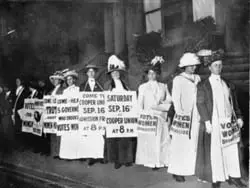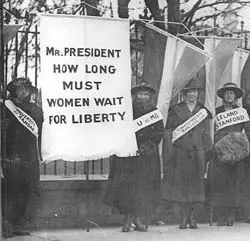Women’s Suffrage
By the 1820’s and 30’s, most men in the United States had been given life freedoms, including property ownership and the right to vote, no matter what their personal or financial situation. Women were still considered ‘property’ of their husbands or fathers and did not have the right to vote in any election.


During this time in history there were a number of organizations forming in America that devoted themselves to moral reforms including temperance clubs, anti-slavery, and religious movements. Women were the dominant people that participated in the clubs and showed that they could be leaders outside the home. There were many women that were beginning to question the roles that society had put on them as submissive wives that were to care for their home, husbands and families. The combination of these two situations were the main reasons behind objections voiced when women were not allowed to vote.

In 1848, a group of mostly women that supported the abolitionist movement met in Seneca Falls, New York to talk about the topic of women’s rights. The women that were leaders on this subject were Elizabeth Cady Stanton and Lucretia Mott and they were in charge of the meeting. The resulting talks ended up in everyone agreeing that women in America were autonomous (not seen as real citizens) and they began discussions on setting up a movement to demand the vote for women.

The 1850’s brought the Civil War and all attention was on the battles, the losses and the eventual passing of the 14th and 15th Amendments to the Constitution. The focus was on freeing the slaves and the changes in the Constitution seemed to identify the idea of ‘citizens’ as being ‘male’. Giving black men the right to vote did not allow women of any race to vote. It was during this time that those that supported the vote for women such as Stanton and Susan B. Anthony moved the woman-suffrage topic forward.


By 1869, they formed the National Woman Suffrage Association and started fighting for an amendment to the Constitution that would include women. A second group was also formed, called the American Woman Suffrage Association. This group felt that the decisions for a vote for women should be done state by state. In 1890, both of the groups merged to create the National American Woman Suffrage Association and Stanton was the first president. They now took the stand that women deserved to vote because they had the ability to create a more moral and pure decision based on ‘maternal commonwealth’.

It took until 1910 and some of the Western states began to include women with the right to vote. Southern and Northern states still refused and this may have been the reason that more radical women’s groups were started, such as the National Women’s Party. This group believed that they needed to draw attention to women’s suffrage in a different way. They held hunger strikes, and picketed (demonstrated) in front of the White House. In some cases, they tied themselves to gates and carried signs. Women from all states began joining the protests.

World War I caused a change in the direction for the country, but women continued to make their voices heard. Their participation in the war effort showed that they were just as deserving as men as patriots of the country. Finally, on August 26, 1920, the Constitution of the United States was ratified with the 19th Amendment, giving women the right to vote.




